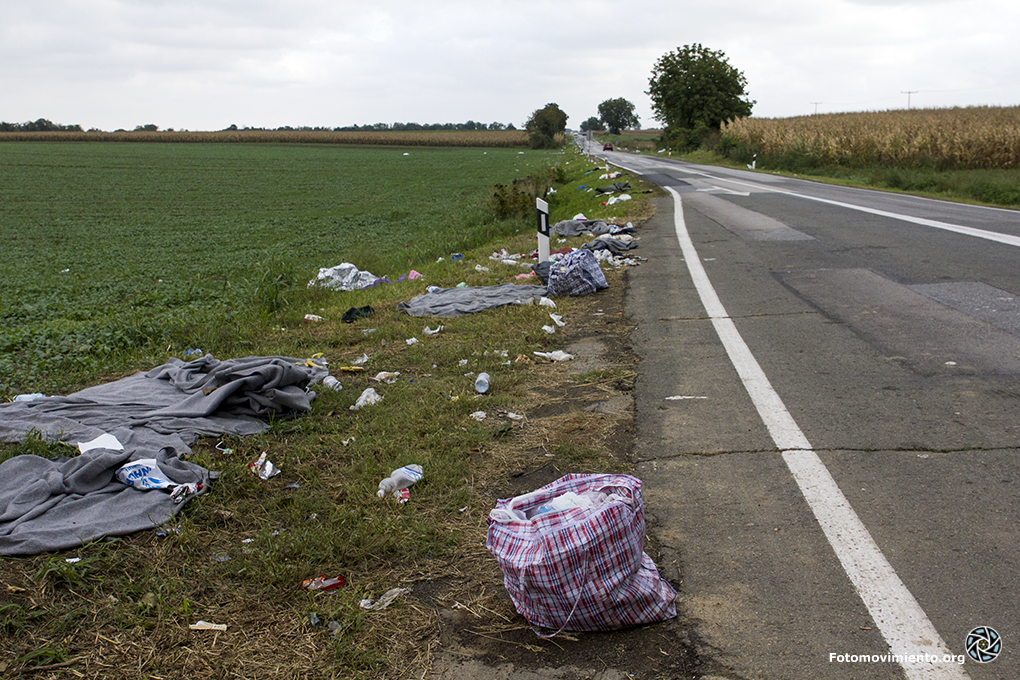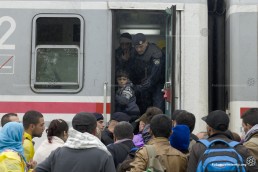(ESP)
Más fotos en Galería Fotomovimiento
CRÓNICAS DESDE HUNGRÍA, SERBIA Y CROACIA.
PASOS FRONTERIZOS
Sid (Serbia) – Tovarnik (Croacia)
Sid (Serbia) – Bapska (Croacia)
CAMPO DE REFUGIADOS
Opatovac (entre Tovarnik y Bapska, Croacia)
Desde detrás de la alambrada un padre con su hijo de menos de diez años nos pide ayuda para buscar a su esposa y a sus tres hijos restantes. Los han separado en Bapska; ella tiene los pasaportes y el poco dinero que les quedaba. Otro chico de Siria nos explica que ha perdido a su hermano. Le preguntamos si puede llamarle. Sonríe. Perdió su móvil aguas griegas, nadando tratando de llegar a Lesbos. Uno de nuestros fotógrafos le pregunta a un palestino que no llega a la treintena “How are you?” “I’m alive, keep smiling.”

Uno de los pasos fronterizos se encuentra entre las poblaciones de Tovarnik (Croacia) y Sid (Serbia). En el pueblo croata hablamos con personal de la ACNUR, la Agencia de la ONU para los Refugiados. O al menos así se hacen llamar. Agencia para los Refugiados. La conversación es formal hasta que introducimos el campo de refugiados habilitado en Opatovac (Croacia). Es en ese momento en el que sacan a pasear sus galones de organización internacional, fiscalizando entre otras la terminología: es un error hablar de “campo de refugiados”, pues son “campos de tránsito”. Preguntamos sobre el origen de las decisiones terminológicas. “Así lo hemos decididos nosotros (ACNUR), que somos el alto comisionado y el gobierno croata”. Y con una sonrisa tensa nos dan a entender que la conversación ha finalizado, pues acaban de decidir que así sea.
La noche del jueves 24 al viernes 25 fue complicada. Diluvió a ritmos intermitentes. Las personas refugiadas en Opatovac se taparon con lonas de plástico para protegerse de la lluvia e intentar descansar como podían. A la vez, centenares de personas se amontonaban en la carretera que conecta Sid (Serbia) y Bapska (Croacia). Una valla metálica les impedía el paso, hasta que los refugiados consiguieron romperla y abrir distintos huecos en ella por donde seguir. Según nos contaban hoy, para algunos de ellos la factura fue de importantes lesiones en brazos y piernas. La versión oficial de la ACNUR rezaba bien distinto: “al ver que estaba cayendo una lluvia torrencial, decidimos abrirles el paso”. Será cuestión de perspectivas. O de terminologías, quizás.

Los refugiados entran en Croacia dirección Bapska y Tovarnik. Al abandonar territorio serbio, en la carretera dirección Bapska son retenidos por la policía croata; separados en grupos de 150 a 200 personas, para irlas trasladando al campo de refugiados de Opatovac. Se aplica el mismo ritual que en el paso fronterizo entre Tovarnik y Sid: después de tenerlos esperando durante horas en tierra de nadie se los llevan a Opatovac. En el campo de refugiados hay capacidad para 4.500 personas, mientras que el flujo de refugiados supera el millar diario con creces.
Separados por más vallas metálicas, el campo de Opatovac es el caos militarizado. Los refugiados obedecen las órdenes de los cuerpos policiales y militares croatas. Las ONG’s y voluntarios se mueven rápido entre unos y otros. Gente de Siria, Palestina, Afganistán, y de otras procedencias. En el campo los refugiados pasan revisión médica y los identifican. Ya no se les tatúa un número de serie en la piel, ahora les ponen una pulserita de papel. Están hasta tres días, luego son trasladados a Tovarnik donde hay una estación de tren. Allí los montan en convoyes dirección Hungría; les dicen que les mandaran a Alemania y Austria.
Fotografías: Moni, Teresa Forn, Manu Gómez, Rober Astorgano, Xavi Ariza y Bru Aguiló.
Texto: Bru Aguiló.
(ENG)
More photos under Galería Fotomovimiento
REPORTS FROM HUNGARY, SERBIA AND CROATIA. PILLS.
BORDER CROSSINGS:
Sid (Serbia) – Tovarnik (Croatia)
Sid (Serbia) – Bapska (Croatia)
REFUGEE CAMPS:
Opatovac (between Tovarnik and Bapska, Croatia)
Behind the wire fence, a father with his 10-year-old son asks us to help him find his wife and his other three children. They have been separated in Bapska and she has all passports and the rest of the little money they have left. Another boy from Syria tells us he has lost his brother. We ask him if he can make him a call. He smiles. He lost his mobile phone in Greek waters while he was swimming when trying to reach Lesbos. One of our photographers asks a Palestinian under his thirties “How are you?” “I’m alive, keep smiling.”
One of the border crossings is located between Tovarnik (Croatia) and Sid (Serbia). In the Croatian town we talk to the UNHCR staff, the UN Refugee Agency. At least this is how they want to be called: Refugee Agency. The conversation is formal until we mention the refugee camp set up in Opatovac (Croatia). It is at that moment when they start showing off their international organization stripes, regulating among others the terminology used: it is a mistake to talk about “refugee camps” because they are “transit camps”. We ask them about the origin of the terminology decisions. “This is how we (UNHCR) decided to call them, we are the high commissioner and the Croatian government. And with a tense smile they let us know that the conversation is over, as they just decided it was over.
The night from Thursday 25th to Friday 25th was complicated. It poured with rain intermittently. The people sheltered in Opatovac were plugged with plastic canvas to protect themselves from the rain and try to have some rest. At the same time, hundreds of people crowded together on the road connecting Sid (Serbia) and Bapska (Croatia). A metallic fence prevented them from crossing until refugees managed to break it and open different holes in it in order to continue their way. We have been told today that some of them got important injuries in their arms and legs. The official version from UNHCR said something very different: “When we saw that it was raining cats and dogs, we decided to pave their way”. It is a matter of different perspectives. Or maybe it is a matter of different terminology.
The refugees enter Croatia and head for Bapska and Tovarnik. When they leave the Serbian territory, on the road to Bapska they are held back by the Croatian police, divided into groups of 150 or 200 people, in order to take them to the refugee camp of Opatovac. They use the same ritual as the one in the border crossing between Tovarnik and Sid: After having them waiting for hours in nowhere land they take them to Opatovac. The refugee camp has capacity for 4,500 people while far more than thousand refugees get there every day.
Isolated through more metallic fences, the Opatovac camp is a militarized chaos. The refugees obey the Croatian police and soldiers orders. The NGOs and volunteers move fast. They come from Syria, Palestine, Afghanistan and other countries. In the refugee camp they are checked up and identified. They are not tattooed with a number on their skin, now they put them a paper bracelet on. They stay there for three days and then they are transferred to Tovarnik where there is a train station. They put them in trains to Hungary. They are told they will be sent to Germany and Austria.
Photos: Moni, Teresa Forn, Manu Gómez, Rober Astorgano, Xavi Ariza and Bru Aguiló
Text: Bru Aguiló
